Proust and His Times
CompLit 7430X
Wednesdays, 6:30-8:10 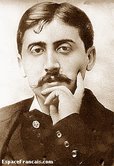
Fall
2018
Required Texts:
Proust, Marcel. Swann's Way. Trans. Moncrieff,
Kilmartin, Enright. Modern Library. 2003.
---Within a Budding Grove. Trans. Moncrieff, Enright. Modern Library.
---Time Regained. Trans. Moncrieff, Enright.
Modern Library.
links to additional readings on website.
handouts
Course Requirements:
There is a lot of reading to do for this course. You
are expected to have read all the material due before each class meeting.
Check the website for assignment updates.
There are 4 response papers. You may write these at
any time during the semester, before we discuss the reading or after,
if you take a different approach from those of the class discussions.
There will be one 5-page midterm paper and a 7-10
page final research paper. For those who would prefer a less formal academic
final paper, there will be other options.
There will be one museum assignment that can be done
either as a midterm project or, in extended form, as the final project.
No late papers. If extraordinary circumstances prevent
you from getting your paper in on time, please email me.
Each student will lead discussion once during the semester---either to introduce
a secondary text or to start a close reading of a particular passage.
Each student will give a 10-15 minute presentation on his or her final paper
topic (last 3 class meetings)
Grades:
25% participation
20% response papers, explications, museum assignments
25% midterm paper
30% final paper
Swann justifies his love for Odette by allusions to
Botticelli
 Bottcelli
Bottcelli
Zipporah "The Trials of Moses" (1481-82)
Sistine Chapel, Rome
"Her loosened hair flowing down her cheeks, bending one knee in a slightly
balletic pose . . . her head on one side, with those great eyes of hers which
seemed so tired and sullen when there was nothing to animate her, she struck
Swann by her resemblance to the figure of Zipporah, Jethro's daughter."
— Swann's Way
 Botticelli
Botticelli
Madonna of the Pomegranate (1487) Galleria degli
Uffizi, Florence
"She [Odette] had at this moment their downcast, heart-broken expression,
which seems ready to succumb beneath the burden of a grief too heavy to be
borne when they are merely allowing the Infant Jesus to play with a pomegranate."
— Swann's Way
Background:
Chronology of Proust's Life and works
(cut and paste the link): http://www.proust-ink.com/
Chronology of the In Search of
Lost Time: Genette
Impressionism (late 19th century)
http://en.wikipedia.org/wiki/Impressionism

Renoir, Mme Charpentier and her Children (1878)
Met. Museum
of Art, New York "Will not posterity,
when it looks at our time, find
the poetry of an elegant home and beautifully dressed
women in the
drawing-room of the publisher Charpentier as painted
by Renoir? Time Regained
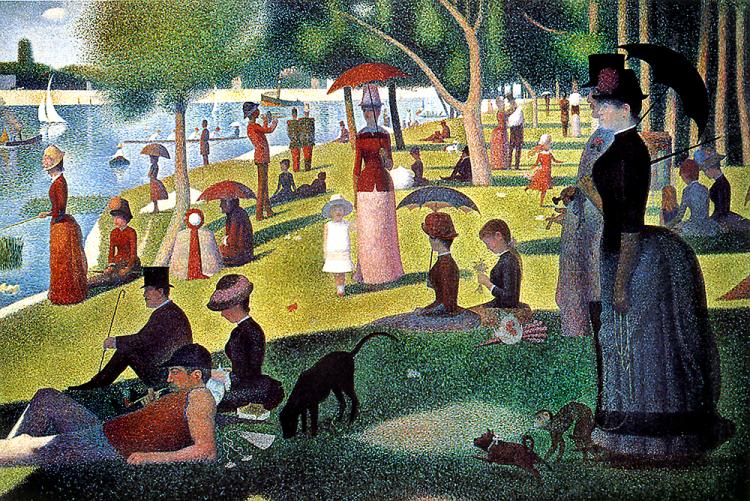
Seurat, A Sunday Afternoon on the Island of the Grande
Jatte, 1886
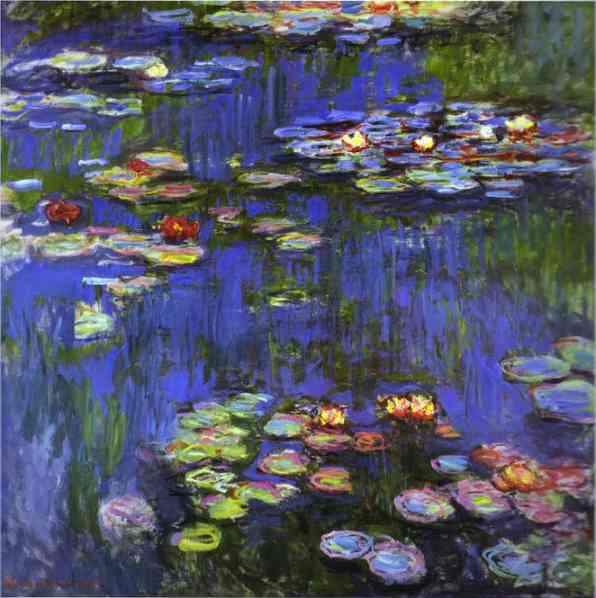 Monet,
Waterlilies (1906)
Monet,
Waterlilies (1906)
See Proust's description of the waterlillies floating
on the Vivonne.
Belle Epoque: 1900-1914
Cubism, Abstract art, posters
http://en.wikipedia.org/wiki/Cubism
Cubism: 1912 pamphlet "Du Cubisme"(Albert
Gleizes and Jean Metzinger, Paris: Eugene Figuiere, 1912, p. 30): "Nothing
is real ouside ourselves, nothing is real except the coincidence of a sensation
and of an individual mental direction. We do not seek to put into question
the existence of objects which strike our senses; but realistically we can
only be certain of the image that they cause to unfold in our minds."
(qtd in J Theodore Johnson, Jr., p. 48, "Proust's 'Impressionism' Reconsidered
in the Light of the Visual Arts of the Twentieth Century" pp. 17-56 in
Twentieth Century French Fiction: Essays for Germaine Bree, ed. Geroge
Stambolian NJ: Rutgers Univ Press, 1975
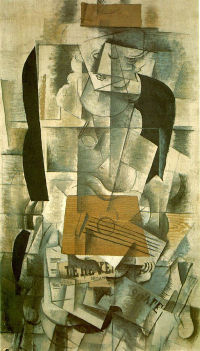
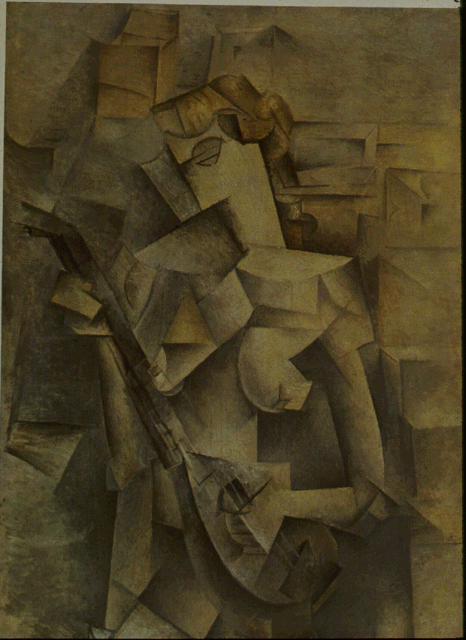

Braque, Woman with a Guitar Picasso,
Woman with a Guitar (1913) Picasso,
Demoiselles d'Avignon (1907)
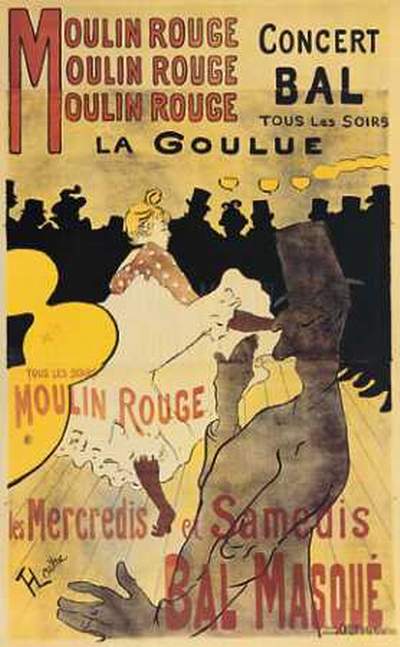
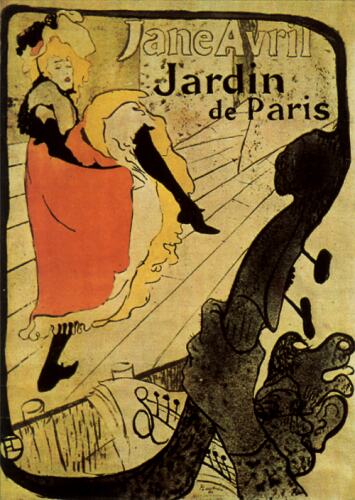
Toulouse Lautrec, Moulin Rouge Jardin
de Paris
Class 1: Aug 29
Background: Turn-of-the-century Paris; Proust biography;
opening paragraphs of Swann's Way
Grandmother's gifts:
 Corot,
Chartres Cathedral (1830) Louvre, Paris
Corot,
Chartres Cathedral (1830) Louvre, Paris
"Instead of photographs of Chartres Cathedral, the Fountains of Saint-Cloud,
of Vesuvius, she would inquire of Swann whether some great painter had not
depicted them, and preferred to give me photographs of "Chartres Cathedral"
after Corot, of the "Fountains of Saint-Cloud" after Hubert Robert,
and of "Vesuvius" after Turner." — Swann's Way
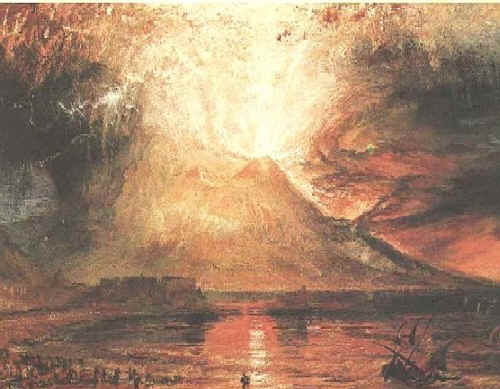 Turner,
Eruption of Vesuvius (1817) Yale Centre for British Art, New Haven
Turner,
Eruption of Vesuvius (1817) Yale Centre for British Art, New Haven
Class 2: Sept 12
Read through p. 124; Read online chapters from Weber, Fin
de siecle,
How They Lived; Affections
and Disaffections
Pay close attention to the madeleine episode (60-64); views of the steeple
of St. Hilaire (88-91); Giotto (110-113)
Read Gilles Deleuze, Proust
and signs
For images of Illiers (Combray) cut and past this link: http://www.proust-ink.com/illiers/
Discussion leader:
Description of servants in Combray:


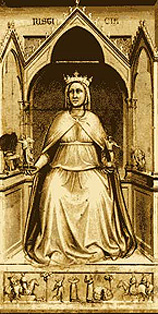
 Giotto,Vices
and Virtues (1305-06) Scrovegni Chapel, Padua "There must have been
a good deal of reality in those Virtues and Vices of Padua, since they seemed
to me as alive as the pregnant servant, and since she herself did not appear
to me much less allegorical." — Swann's Way
Giotto,Vices
and Virtues (1305-06) Scrovegni Chapel, Padua "There must have been
a good deal of reality in those Virtues and Vices of Padua, since they seemed
to me as alive as the pregnant servant, and since she herself did not appear
to me much less allegorical." — Swann's Way
Class
3: Sept 26:
Read through p. 339 of Swann's Way
Discussion leader: Amanda
Possible reponse papers: one page, double spaced, 12-point font:
1. hawthorns, p. 155-156; 158 (middle paragraph);
193-197
2. steeples at Martinville - 253 (bottom) - 255
3. Odette and the cattleyas - p. 328-331
3. reaction to, or close analysis of, any passage that
particularly interests you.
Class 4: Oct 3:
Read Swann in Love through p. 490; "Debussy
in Fin de siecle Paris" http://www.academia.edu/5330805/Debussy_in_fin-de-siecle_Paris
Discussion leader:
Possible response paper topics: or do a close analysis
of a paragraph of your choice:
1. sadism (Mlle Vinteuil and her lover)
2. the little phrase: Debussy,
Faure, Franck - Discussion leader: Yuna
3. Explain the quote on p. 391: "...he had now, by his jealousy,
given her the proof that he loved her too much, which, between a pair of lovers,
for ever dispenses the recipient from the obligation to love enough.
Monet and the water lilies on the Vivonne
Class 5: Oct. 10: Finish Swann's Way
Online reading:
Freud, Proust and Lacan
Discussion leader:
Swann's dream: 538-541; Discussion leader: Olena
Art: impressionism; cubism; abstract art; Fashion:
Worth, Fortuny
Read the Chic Parisienne from Ruth Iskin, Modern
Women and Parisian Consumer Culture in Impressionist Painting Discussion
leader: Maria
fashion links:
Worth gowns: http://www.metmuseum.org/toah/hd/wrth/hd_wrth.htm
Fortuny: http://www.metmuseum.org/toah/hi/hi_fort.htm
Art links (webmuseum) http://www.ibiblio.org/wm/paint/tl/20th/
Dance: Stravinsky, Ballets russes
For a comparative translation from Swann's Way, click here:
http://www.readingproust.com/madelein.htm
Discussion leader:
Poiret at the Metropolitan Museum of Art
As you look at the collection, pay careful attention to
the classical forms of the dresses---the draping (particularly the Champs
Elysees gown), the sleek lines, the colors. Identify particular dresses that
Odette could have been wearing in the time of her early relationship with
Swann (hint: the decor in her apartment) and those that some of the guests
at the final party at the Princesse de Guermantes' would be wearing. What
makes these clothes modern? What distinguishes them from the fashions
that preceded them (some of the things we looked at from Fortuny and Worth---check
the websites above).
A review of the exhibit from The New Yorker
http://www.newyorker.com/arts/critics/artworld/2007/05/21/070521craw_artworld_thurman/
Possible response paper topics:
1. Describe the Verdurin salon
2.Select a passage for close analysis
3. jealousy
4. Write about any aspect of these pages that intrigues,
confuses, or mystifies you.
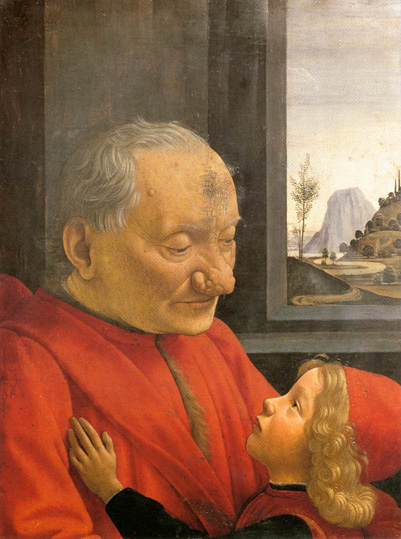 Ghirlandaoi,
Old Man with his Grandchild. Louvre, Paris
Ghirlandaoi,
Old Man with his Grandchild. Louvre, Paris
"He [Swann] had always found a peculiar fascination in tracing in the
paintings of the old masters not merely the general characteristics of the
people whom he encountered in his daily life, but rather what seems least
susceptible of generalization, the individual features of men and women whom
he knew . . . in the colouring of a Ghirlandaio, the nose of M. de Palancy."
— Swann's Way
Class 6: Oct 17
We will finish volume 1, with particular attention
to the last section, Place Names: The Name; fashion (see last week's reading);
translation (passage from the French, Kilmartin translation, Davis translation)
Extra reading:
Close
analysis: Discussion leaders: Shoshana
Narrative Discourse, Genette
For an interesting article on the organization of Swann
in Love, see Jean-Pierre Boon's "Concentric Patterns in Un Amour
de Swann," Modern Language Studies, vol 17 No. 3, Summer 1987
(jstor) Discussion leader:
Possible response paper topics:
1. Explain: "For what we
suppose to be our love or our jealousy is never a single, continuous and indivisible
passion....love and suspicion."
(p. 529)
2. Examine the connection between the closing dream
of "Swann in Love" and the opening section of "Place-Names."
3. Compare the Narrator to Swann.
4. Explain the allusions and symbols in the description
of the Bois de Boulogne (592-594).
Description of Bloch:
h Bellini,
Mahomet ,The Sultan Mehmet II (1480) National Gallery, London
Bellini,
Mahomet ,The Sultan Mehmet II (1480) National Gallery, London
"I said it was Bloch. 'Oh, yes, that boy I saw
here once, who looks so like the Bellini portrait of Mahomet II. It's an astonishing
likeness; he has the same arched eyebrows and hooked nose and promient cheekbones.
When he has a little beard he'll be Mahomet himself.'" — Swann's Way
Class 7 and 8: Oct 24 and Oct. 31
Within a Budding Grove
Read p. 1-11; 85-90; 116-119; 261-73; 299-366; 420-474
Additional readings from Gilles Deleuze, Levels of
the search:
Discussion leader:
Close analysis: Discussion leaders: Jessica
Bloom, Proust and Jealousy.
Discussion leader:
For Wednesday, Oct 31: If you need to limit your reading, be sure to read
503-516; 558-581; 593-606; 643-692; 706-730. Find a passage that you would
like to discuss in class.
Suggested reading: Bales,
Proust and the Fine Arts (especially on Elstir and Vinteuil)
Discussion leaders:
Midterm
paper: Due Wednesday, Oct 31:
5 pages, double spaced, 12 pt. font, 1" margins. You can e-mail
the paper to me before midnight on the 31st. NO LATE PAPERS ACCEPTED.
1. Examine the connection between Proust and Vermeer.
Why does Swann study this particular painter? What was Vermeer's place in
the artistic world of turn-of-the-century Paris?
2. Examine the
connections between Proust and contemporary psycological theory.
3. Discuss the
Proustian analogy between love and sickness.
4. Floral imagery
in Proust (hawthorns, cattleyas, chrysantemums)
5. Vinteuil's
little phrase and Swann's love.
6. Choose one artistic analogue and analyze how Proust
uses it.
or compare the photos with a Parisian street description
in Proust.
7. Choose either a Vermeer or a Monet and
write a description of the painting in Proustian style. I don't expect you
to be able to duplicate the style, but you should be able to capture the flavor,
mood, cadence of Proustian description. This topic is meant for those who
want to play with creative writing.
8. Visit the furniture rooms at the Met.
Find two different rooms (if not entire rooms, then particular pieces from
different rooms) that you can associate with one of the salons in the Search.
Write a page paper analyzing how and why the particular pieces you selected
fit the particular salon. You could choose Odette's salon, Mme Verdurin's,
the Guermantes', Charlus' home.
OR:
A topic of your choice, but you must have it approved by me BEFORE you write.
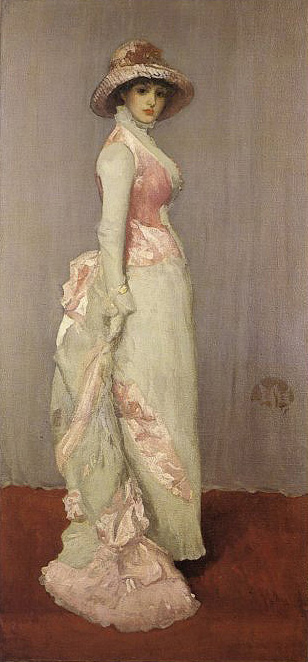 Whitstler,
Harmony in Pink and Grey: Portrait of Lady Meux (1881) Frick Collection,
New York
Whitstler,
Harmony in Pink and Grey: Portrait of Lady Meux (1881) Frick Collection,
New York
"And sometimes to a sky and sea uniformly grey a touch of pink would
be added with an exquisite delicacy . . . this 'Harmony in Grey and Pink'"
— Within a Budding Grove
Class 9, 10, 11: Here are the pages from Volume 3 (The
Guermantes Way): 92-11; 173-185; 357-366; 403-441;469-471; 493-502; 573-578;
793-819
on line pdf: Guermantes Way
Vol 4 (Sodom and Gomorrah): 1-43;
171-173; 190-197; 204-220; 236-245; 699-711; 718-724
on line pdf:
Vol 5 (The Captive
& The Fugitive): 1-11; 75-100; 146-160; 204-210; 228-250; 268-287;
331-353; 440-558; 719-752; 844-890
on line pdf:
Class 9: Nov. 7
Read the excerpts from The
Guermantes Way Discussion leader (close analysis):
Dreyfus Affair:
Look at the NYU site, with
postcards from the time of the Affair:
http://modiya.nyu.edu/handle/1964/375
Read: http://www.newyorker.com/arts/critics/books/2009/09/28/090928crbo_books_gopnik
Discussion leader:
Class 10: Nov. 14
Read excerpts from Sodom and Gommorah
posted online. Pay particular attention to the portrait of Charlus.
Read "The
Myth and Science of Homosexuality" in Homosexuality
in French Literature by J. E. Rivers Discussion leader:
and the excerpt on Charlus in the brothel Discussion
leader (close analysis): Brianna
Bring in a sentence, episode, paragraph, word that you want to discuss in
class.
time and
sense, 83-99 by Julia Kristeva.. Discussion leader:
Matt
Possible Response paper topics:
Choose a passage to closely analyze from any of the
sections due this week, or write on any topic, theme, motif that
catches your interest in these pages.
Or, respond to either the Rivers or the Kristeva excerpt.
Class 11: Nov. 21
Read excerpts from The
Captive and the Fugitive
reading: Dutch
Painting (Yeazell) Discussion leader:
Close analysis: View of Delft: Discussion leader:
Proust and Signs, Presence
of Madness (Deleuze) Discussion leader:
Marville photographs
Close reading: pages 342 - 343 in the The Captive,"Each artist…will
eventually emerge" to "Composers do not remember..compose his soul."
Discussion leader: Nomi
Suggested reading: Landy, "Sentence
Structure," in Philosophy as Fiction
Kristeva, Metonymy,
from Time and Sense
Class 12: Nov. 28:
Time Regained; p. 105-130; 161-169; 180-207; Read more if you have the
time.
Kristeva, p. 292-304, The Final
Sentence, in Time and Sense:
Michael Wood, "The Death of Paradise," Philosophy and Literature
21, 2(1997): 245-261 (available on JStor). Discussion leader:
Kristeva on Venice
in Time and Sense:
Pick a sentence or a scene that you want to discuss in class. Discussion
leaders: Kayla
Start thinking about a topic for a final, 7-10 page paper. Oral presentations
the last two class meetings.
Class 13: Dec. 5: SUBMIT FINAL PAPER TOPICS
Paper proposal : A clear, limited topic for your paper, stating the
question that you will explore and the argument you will make.
A list of at least 4 scholarly secondary sources. This should be in MLA format.
A list of at least 3 passages from the primary text that you will analyze
closely in your paper as support for your argument. You will not merely summarize
the passages, but rather subject them to a close, detailed reading that yields
evidence to support your argument.
finish Time Regained, p.255-330; 481-531.
Kristeva, p. 292-304, The Final
Sentence, in Time and Sense:
Discussion leader: Will
Possible response papers:
From the Captive and the Fugitive: Vinteuil septet; View of
Delft
Close
analysis of a passage of your choice; or wirte on any theme of your choice
From Time Regained:
The paving stones in the Guermantes' courtyard.
Explain the quote: "The true paradises are the
paradises we have lost." (261).
A passage, or a topic, of your choice.
Old Odette (382-84)
Close analysis of p. 412 "To return....no longer
there."
Bloch's monocle (p. 385)
Class 14 and 15: Dec 12, Dec.
19: 10-minute presentation on your paper topic. These presentations will take
the following form: Once you've selected your topic (and cleared it with me),
pick one sentence from the novel that is in some way relevant to your topic.
You will lead the class discussion focusing on that sentence for your oral
presentation. You need to e-mail the sentence to me so that I can send it
to all class members and project it on the screen for all to see.
Presentation schedule:
Wednesday, Dec. 12: presenters: Jessica; Shoshanna; Will;
Yuna; Olena
Wednesday, Dec. 19: presenters: Nomi; Amanda; Matt; Briana; Kayla; Maria
Final papers due, by e-mail,
Dec. 19. You must clear your topic with me by Dec. 5. Final papers need at
least four secondary sources (all scholarly sources----can include interviews,
films, articles, books)
Study Guide Questions (from www.tempsperdu.com)
- Be prepared to discuss these questions in class
1. Early in Swann's Way Proust
writes: "Our social personality is a creation of the minds of others
" (19), and in Contre Saint-Beuve Proust makes a distinction between
the "moi social" and the "moi profond." How does Proust
illustrate the disjunction throughout the novel?3
2. The Narrator states, "since I did not know where I was, I did not
understand in the first moment who I was"(5). Consider the ways in which
Proust writes about the self and the recovery of place as well as the recovery
of time.
3. Pay attention to the text's logic of emptiness and fulfillment, deprivation
and plenitude, hunger and satiety, absence and presence, as well as excess
or superabundance.
In Time Regained the Narrator claims that "The true paradises
are the paradises we have lost" (ML 261), but Combray is far from paradisial.
What kind of place is it? And what does this say about character of the Narrator's
nostalgia?
4. In terms of the narrative, what is the relationship between "Awakenings"
and the "episode of the madeleine"?
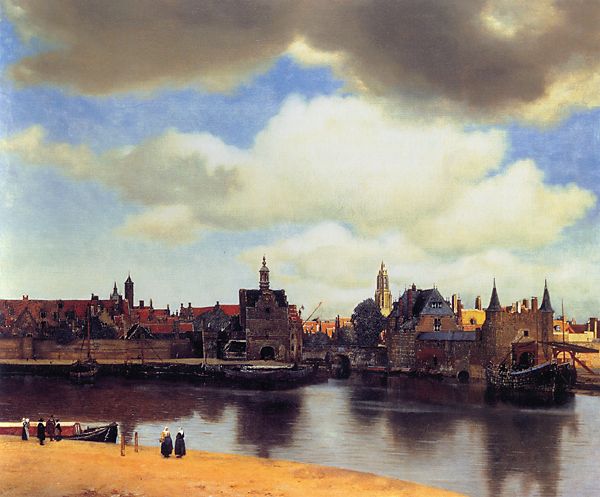 Vermeer,
View of Delft, Mauritshuis, The Hague
Vermeer,
View of Delft, Mauritshuis, The Hague
At last he came to the Vermeer
which he remembered as more striking, more different from anything else he
knew . . . he noticed for the first time some small figures in blue, that
the sand was pink, and finally, the precious little patch of wall. 'That's
how I ought to have written'." The Captive

 Bottcelli
Bottcelli Botticelli
Botticelli

Monet,
Waterlilies (1906)




 Corot,
Chartres Cathedral (1830) Louvre, Paris
Corot,
Chartres Cathedral (1830) Louvre, Paris Turner,
Eruption of Vesuvius (1817) Yale Centre for British Art, New Haven
Turner,
Eruption of Vesuvius (1817) Yale Centre for British Art, New Haven


 Giotto,Vices
and Virtues (1305-06) Scrovegni Chapel, Padua "There must have been
a good deal of reality in those Virtues and Vices of Padua, since they seemed
to me as alive as the pregnant servant, and since she herself did not appear
to me much less allegorical." — Swann's Way
Giotto,Vices
and Virtues (1305-06) Scrovegni Chapel, Padua "There must have been
a good deal of reality in those Virtues and Vices of Padua, since they seemed
to me as alive as the pregnant servant, and since she herself did not appear
to me much less allegorical." — Swann's Way  Ghirlandaoi,
Ghirlandaoi,
 Bellini,
Mahomet ,The Sultan Mehmet II (1480) National Gallery, London
Bellini,
Mahomet ,The Sultan Mehmet II (1480) National Gallery, London Whitstler,
Harmony in Pink and Grey: Portrait of Lady Meux (1881) Frick Collection,
New York
Whitstler,
Harmony in Pink and Grey: Portrait of Lady Meux (1881) Frick Collection,
New York